Towards Sustainable Food Security in the Sahel: Integrating Traditional Conservation Practices and Controlled Irrigation to Overcome Water Scarcity During the Dry Season for Onion and Jute Production
Abstract
1. Introduction
2. Materials and Methods
2.1. Study Area Description
2.2. Description of the Experimental Set-Up
2.3. Set-Up of the Cultivation Techniques
2.3.1. The Zaï
2.3.2. The Half-Moon
2.3.3. Flat Tillage
2.4. Plant Material Description
2.4.1. The Onion
2.4.2. The Jute
2.5. Plant Set-Up
2.5.1. Setting Up the Onions
2.5.2. Set-Up of the Jute
- Breaking seed dormancy
- Sowing in the plots
2.6. Irrigation Technique Description
2.7. Maintenance and Harvesting
2.8. Physical and Hydrodynamic Characterization of the Experimental Site
2.9. Key Mineral Elements and Physical Parameters
2.10. Data Processing
3. Results
3.1. Physical Characteristics of the Site Soil
3.2. Yield Evaluation
3.2.1. Onion Yields According to Soil Treatments
3.2.2. Jute Yields Depending on Soil Treatments and Harvests
4. Discussion
5. Practical Applications of the Study
6. Conclusions
Supplementary Materials
Author Contributions
Funding
Institutional Review Board Statement
Informed Consent Statement
Data Availability Statement
Acknowledgments
Conflicts of Interest
References
- Gadédjisso-Tossou, A.; Egbendewe-Mondzozo, A.; Abbey, G.A. Assessing the Impact of Climate Change on Smallholder Farmers’ Crop Net Revenue in Togo. J. Agric. Environ. Int. Dev. 2016, 110, 229–248. [Google Scholar] [CrossRef]
- Field, C.B.; Barros, V.R.; Dokken, D.J.; Mach, K.J.; Mastrandrea, M.D.; Bilir, T.E.; Chatterjee, M.; Ebi, K.L.; Estrada, Y.O.; Genova, R.C.; et al. GIEC Changements Climatiques 2014: Incidences, Adaptation et Vulnérabilité—Résumé à L’intention des Décideurs; Contribution Du Groupe de Travail II Au Cinquième Rapport D’évaluation du Groupe Intergouvernemental D’experts Sur L’évolution du Climat; Changement Climatique; Organisation Métérologique Mondiale: Geneva, Switzerland, 2014; p. 34. [Google Scholar]
- Jones, P.G.; Thornton, P.K. Croppers to Livestock Keepers: Livelihood Transitions to 2050 in Africa Due to Climate Change. Environ. Sci. Policy 2009, 12, 427–437. [Google Scholar] [CrossRef]
- Dasgupta, S.; Hossain, M.M.; Huq, M.; Wheeler, D. Climate Change, Salinization and High-Yield Rice Production in Coastal Bangladesh. Agric. Resour. Econ. Rev. 2018, 47, 66–89. [Google Scholar] [CrossRef]
- Chandler, M. How Does Climate Change Affect Agriculture? Available online: https://www.heifer.org/blog/how-climate-change-affects-agriculture.html (accessed on 29 May 2024).
- Chadalavada, K.; Kumari, B.D.R.; Kumar, T.S. Sorghum Mitigates Climate Variability and Change on Crop Yield and Quality. Planta 2021, 253, 113. [Google Scholar] [CrossRef] [PubMed]
- Mertz, O.; Mbow, C.; Nielsen, J.; Maiga, A.; Diallo, D.; Reenberg, A.; Diouf, A.; Barbier, B.; Moussa, I.; Zorom, M.; et al. Climate Factors Play a Limited Role for Past Adaptation Strategies in West Africa. Ecol. Soc. 2010, 15, 25. [Google Scholar] [CrossRef]
- Sarr, B.; Mohamed, L.; Seyni, S.; David, A.G.; Sanoussi, A. Adapting to Climate Variability and Change in Smallholder Farming Communities: A Case Study from Burkina Faso, Chad and Niger. J. Agric. Ext. Rural Dev. 2015, 7, 16–27. [Google Scholar] [CrossRef]
- Wildemeersch, J.C.J.; Garba, M.; Sabiou, M.; Sleutel, S.; Cornelis, W. The Effect of Water and Soil Conservation (WSC) on the Soil Chemical, Biological, and Physical Quality of a Plinthosol in Niger. Land Degrad. Dev. 2015, 26, 773–783. [Google Scholar] [CrossRef]
- Nyamekye, C.; Thiel, M.; Schönbrodt-Stitt, S.; Zoungrana, B.J.-B.; Amekudzi, L.K. Soil and Water Conservation in Burkina Faso, West Africa. Sustainability 2018, 10, 3182. [Google Scholar] [CrossRef]
- Touré, A.; Tidjani, A.D.; Rajot, J.L.; Marticorena, B.; Bergametti, G.; Bouet, C.; Ambouta, K.J.M.; Garba, Z. Dynamics of Wind Erosion and Impact of Vegetation Cover and Land Use in the Sahel: A Case Study on Sandy Dunes in Southeastern Niger. CATENA 2019, 177, 272–285. [Google Scholar] [CrossRef]
- Hanadé, I.; El Mansouri, L.; Gadal, S.; Faouzi, E.; Abdourhamane Touré, A.; Garba, M.; Imani, Y.; El-Ayachi, M.; Hadria, R. Drought Vulnerability of Central Sahel Agro-Systems: A Modelling-Approach Based on Magnitudes of Changes and Machine Learning Techniques. Int. J. Remote Sens. 2023, 44, 4262–4300. [Google Scholar] [CrossRef]
- Karambiri, B.; Gansaonré, N. Variabilité Spatio-Temporelle de la Pluviométrie dans les Zones Soudaniennes, Soudano-Sahélienne et Sahélenne du Burkina Faso. Eur. Sci. J. 2023, 3, 3–22. [Google Scholar] [CrossRef]
- Niang, D.; Mahamadou, K.; Keita, A.; Houndayi, M.; Zoure, C.O.; Dara, A. Estimation of Soil Hydrodynamic Parameters Related to Agricultural Practices Case of the Tougou Experimental Site (Burkina Faso). J. Environ. Sci. Eng. A 2017, 6, 527. [Google Scholar] [CrossRef]
- Zoure, C.O.; Queloz, P.; Mahamadou, K.; Niang, D.; Fowe, T.; Lawani Adjadi, M.; Yonaba, R.; Consuegra, D.; Hamma, Y.; Karambiri, H. Étude Des Performances Hydrologiques Des Techniques Culturales Dans Un Contexte de Changement Climatique En Zone Sahélienne Du Burkina Faso. In Proceedings of the Désertif’Actions’19, Ouagadougou, Burkina Faso, 19–22 June 2019. [Google Scholar] [CrossRef]
- Niang, D. Fonctionnement Hydrique de Différents Types de Placages Sableux dans le Sahel Burkinabè. Ph.D. Thesis, EPFL, Lausanne, Switzerland, 2006; p. 167. [Google Scholar] [CrossRef]
- Niang, I.; Ruppel, O.C.; Ama, E.; Lennard, C.; Abdrabo, M.A.; Padgam, J.; Urquhart, P. Climate Change 2014: Impacts, Adaptation and Vulnerability—Contributions of the Working Group II to the Fifth Assessment Report of the Intergovernmental Panel on Climate Change; Cambridge University Press: Cambridge, UK, 2014; pp. 1199–1265. [Google Scholar]
- Zongo, B. Stratégies Innovantes D’adaptation à la Variabilité et au Changement Climatiques au Sahel: Cas de L’irrigation de Complément et de L’information Climatique dans les Exploitations Agricoles du Burkina Faso. Ph.D. Thesis, Institut International d’Ingénierie de l’Eau et de l’Environnement (2iE), et Université de Liège, Ouagadougou, Burkina Faso, 2016. [Google Scholar]
- Da, C.É.D. Impact des techniques de conservation des eaux et des sols sur le rendement du sorgho au centre-nord du Burkina Faso. Cah. D’outre-Mer. Rev. Géogr. Bordx. 2008, 61, 99–110. [Google Scholar] [CrossRef]
- Sultan, B.; Roudier, P.; Traoré, S. Les impacts du changement climatique sur les rendements agricoles en Afrique de l’Ouest. Chapitre 10. In Les Sociétés Rurales Face aux Changements Climatiques et Environnementaux en Afrique de l’Ouest; Sultan, B., Lalou, R., Amadou Sanni, M., Oumarou, A., Soumaré, M.A., Eds.; IRD Éditions: Paris, France, 2015; pp. 209–225. ISBN 978-2-7099-2146-6. [Google Scholar]
- Waongo, M.; Laux, P.; Kunstmann, H. Adaptation to Climate Change: The Impacts of Optimized Planting Dates on Attainable Maize Yields under Rainfed Conditions in Burkina Faso. Agric. For. Meteorol. 2015, 205, 23–39. [Google Scholar] [CrossRef]
- Banque Mondiale. Améliorer La Productivité Agricole et La Sécurité Alimentaire: Une Priorité Pour Le Burkina Faso. 2016. Available online: https://www.banquemondiale.org/fr/news/feature/2016/02/10/improving-food-security-and-agricultural-productivity-a-priority-for-burkina-faso (accessed on 4 June 2024).
- Neya, T.; FAO; EU. CIRAD Food System Profile in Burkina Faso. 2021. Available online: https://www.researchgate.net/publication/354870396_Food_System_Profile_in_Burkina_Faso (accessed on 28 July 2024).
- Kiebre, M.; Kando, P.; Kiebre, Z.; Mahamadou, S.; Sawadogo, N.; Sawadogo, B.; Nanema, R.; Traore, E. Evaluation Agromorphologique d’accessions de Corète Potagère (Corchorus olitorius. L) Du Burkina Faso. Int. J. Innov. Appl. Stud. 2016, 14, 198–209. [Google Scholar]
- Yanogo, P. Rainfall Variability and Changes in Market Gardening Systems: A Case Study in Réo (Mid-West Region of Burkina Faso). Present Environ. Sustain. Dev. 2024, 17, 213–228. [Google Scholar] [CrossRef]
- Lajaunie, M.L. Annexe 2: Evaluation des Ressources en Eau et des Demandes Sectorielles—Bilan Besoins-Ressources; Amelioration de la Connaissance et de la Gestion des Eaux au Burkina Faso; Banque Mondial: Ouagadougou, Burkina Faso, 2017. [Google Scholar]
- Sossou, S.; Igue, C.B.; Diallo, M. Impact of Climate Change on Cereal Yield and Production in the Sahel: Case of Burkina Faso. Asian J. Agric. Ext. Econ. Sociol. 2019, 37, AJAEES.53835. [Google Scholar] [CrossRef][Green Version]
- Roose, E.; Kabore, V.; Guenat, C. Le zaï, une technique traditionnelle africaine de réhabilitation des terres dégradées de la région soudano-sahélienne (Burkina-Faso). In Proceedings of the International Congress on the Restoration of Degraded Lands, Arid and Semi-Arid Zones, Tunis, Tunisia, 14–19 November 1994; Volume 17. [Google Scholar]
- Biswas, S.K.I.; Sarker, P.K.; Islam, A.K.M.M.; Bhuiyan, M.A.; Kundu, B.C. Effect of Irrigation on Onion Production. Pak. J. Biol. Sci. 2003, 6, 1725–1728. [Google Scholar]
- Hama-Ba, F.; Parkouda, C.; Kamga, R.; Tenkouano, A.; Diawara, B. Availability, Patterns and Frequency of Consumption of Traditional African Vegetables in Four Localities with Various Market Gardening Activities in Burkina Faso: Ouagadougou, Koubri, Loumbila, Kongoussi. Afr. J. Food Agric. Nutr. Dev. 2017, 17, 11552–11570. [Google Scholar] [CrossRef]
- Souleymane, H.D.; Kouakou, N.; Angbo Kouakou, E.; Soro, Y. Caractérisation Morphologique et Ethnobotanique Des Cultivars de “Kroala” (Corchorus olitorius L.), Légume-Feuille Traditionnel Consommé Dans Les Régions Du Centre de La Côte d’Ivoire: Morphological and Ethnobotanical Characterization of “Kroala” (Corchorus olitorius L.) Cultivars, a Traditional Leafy Vegetable Consumed in the Central Regions of Côte d’Ivoire. Int. J. Biol. Chem. Sci. 2023, 17, 363–377. [Google Scholar] [CrossRef]
- Moreau, B.; Le Bohec, J.; Guerber-Cahuzac, B. L’oignon de Garde; Interprofessional Technical Center for Fruits and Vegetables: Nancy, France, 1996; p. 320. [Google Scholar]
- Gerbeaud. Le Système Racinaire. Available online: https://www.gerbeaud.com/jardin/decouverte/systeme-racinaire,1375.html (accessed on 13 October 2024).
- Mohammad, S.I.; Mohammad, A. World Production of Jute: A Comparative Analysis of Bangladesh. Int. J. Manag. Bus. Stud. 2011, 2, 14–22. [Google Scholar]
- Leblanc, M. Physiologie de l’oignon: Comprendre La Plante Pour Bien La Cultiver. Saint-Rémi. 2017. Available online: https://www.agrireseau.net/documents/96636/physiologie-de-l_oignon-comprendre-la-plante-pour-bien-la-cultiver (accessed on 28 July 2024).
- Kandasamy, G.; Sundaresan, S.; Krishna, K.R.; Kumar, M.; Alagarsamy, R. Integrated Nutrient Management in Onion—A Review. Ecol. Environ. Conserv. 2022, 28, 182–192. [Google Scholar] [CrossRef]
- Tarchiani, V.; Robbiati, G.; Salifou, M. The Onion Sector of West Africa: Comparative Study of Niger and Benin. Cah. Agric. 2013, 22, 112–123. [Google Scholar] [CrossRef]
- DPSAA Rapport d’analyse Du Module Maraichage, Bureau Centrale de Recensement Général de l’Agriculture. Ministère de l’Agriculture de l’Hydraulique, et Des Ressources Halieutiques, Burkina Faso; Direction de la Prospective et des Statistiques Agricoles et Alimentaires. 2011, p. 237. Available online: https://www.ipcinfo.org/fileadmin/user_upload/countrystat_fenix/congo/docs/Rapport_General_des_resultats_previsionels_2010_2011%20finalx.pdf (accessed on 21 July 2024).
- Son, G.; Kiogo, R.; Ye, S.G. Analyse Des Systèmes de Production de l’oignon Bulbe Autour Du Barrage de Goinré Dans La Province Du Yatenga Au Nord Du Burkina Faso. Int. J. Biol. Chem. Sci. 2016, 10, 1173–1183. [Google Scholar] [CrossRef][Green Version]
- Ouedraogo, A.R.; Kambire, F.C.; Isola, R.A.; Nebie, R.H.C.; Somda, I. Pratiques de fertilisation maraichère et pourriture post-récolte des bulbes d’oignon (Allium cepa L.) au Burkina Faso. Sci. Nat. Appl. 2020, 39, 12. [Google Scholar]
- Ricroch, A.; Rouamba, A.; Sarr, A. Valorisation de La Production de l’oignon En Afrique de l’Ouest Par La Gestion Dynamique de Ses Ressources Génétiques. Acta Bot. Gall. 1996, 143, 101–106. [Google Scholar] [CrossRef][Green Version]
- Fritsch, R.; Friesen, N. Evolution, Domestication and Taxonomy. In Allium Crop Science: Recent Advances; Cabi Digital Library: Wallingford, UK, 2002. [Google Scholar]
- Abdou, R.; Bakasso, Y.; Adam, T.; Saadou, M.; Baudoin, J.-P. Biologie, diversité et outils pour l’analyse de la diversité génétique de l’oignon, Allium cepa L. (synthèse bibliographique). Biotechnol. Agron. Soc. Environ. 2015, 19, 184–196. [Google Scholar]
- Eklu-Natey, R.D.; Balet, A.; Ahyi, M.A.; Adjanohoum, E.j.; Ake Assi, L.; Borst, F.; Chatelain, C.; Diallo, D.; Hostettmann, L.; Sanou, L.; et al. Pharmacopée africaine, Dictionnaire et monographies multilingues du potentiel médicinal des plantes africaines. Afrique de l’Ouest. J. Des Afr. 2013, 2, 202–205. [Google Scholar] [CrossRef]
- ASMA. Corchorius Olitorius AS 117; Youtube. 2020. Available online: https://www.youtube.com/watch?v=aEq_EITCHyQ&t=1528s (accessed on 28 September 2024).
- Sanni, G.; Legba, E.; Aglinglo, L.; Djido, U.; Francisco, R.; Fassinou Hotegni, V.N.; Achigan-Dako, E. Fiche Technique Synthétique Pour La Production de La Corète Potagère (Corchorus olitorius L.); Bibliothèque Nationale du Bénin, 3ième Trimestre; (GBioS), Université d’Abomey-Calavi (UAC): Abomey-Calavi, Benin, 2020; ISBN 978-99919-78-50-5. [Google Scholar]
- Alissou, A.E. Analyse des pratiques culturales maraîchères dans les bas-fonds rizicoles d’Agbédranfo-Vovokanmey (Couffo) et de Houinga (Mono) au sud-Bénin, et effet de l’azote sur la croissance et la production du crincrin (Corchorus olitorius L.). Master’s Thesis, (GBioS), Université d’Abomey-Calavi (UAC), Abomey-Calavi, Benin, 2011. [Google Scholar]
- Fondio, L.; Grubben, G.J.H. Corchorus olitorius L. Record from PROTA4U; PROTA (Plant Resources of Tropical Africa/Ressources Végétales de l’Afrique Tropicale): Wageningen, The Netherlands, 2011; Available online: https://www.prota4u.org/database/ (accessed on 29 September 2023).
- Fondio, L.; N’zi, J.-C.; Mahyao, A.; Agbo, A.; Djidji, A.H.; N’Gbesso, M. Bien Cultiver L’amarante, La Célosie, La Corète Potagère et La Morelle Noire; Centre National de Recherche Agronomique: Abidjan, Côte d’Ivoire, 2013. [Google Scholar]
- Robert, R. Potager Hors sol Comment bien Estimer sa Profondeur? Available online: https://www.potagercaillebotte.fr/lestimation-de-la-profondeur-dun-potager-hors-sol/ (accessed on 3 October 2023).
- Ministère de l’Agriculture du Niger; AID Projet de Développement Des Exportations et Des Marchés Agro-Sylvo-Pastoraux (PRODEX), Guide de Bonnes Pratiques de Production, Stockage et Conservation de l’oignon. 2012. Available online: https://reca-niger.org/spip.php?article550 (accessed on 28 May 2024).
- Bertone, F.; Sou, M. Improving Groundwater Development in the Sahel Region. World Bank Blogs. 2023. Available online: https://blogs.worldbank.org/en/water/improving-groundwater-development-sahel-region (accessed on 1 June 2024).
- Kar, G.; Verma, H.N.; Singh, R. Effects of Winter Crop and Supplemental Irrigation on Crop Yield, Water Use Efficiency and Profitability in Rainfed Rice Based Cropping System of Eastern India. Agric. Water Manag. 2006, 79, 280–292. [Google Scholar] [CrossRef]
- Dembele, Y.; Yacouba, H.; Keïta, A.; Sally, H. Assessment of Irrigation System Performance in South-Western Burkina Faso. Irrig. Drain. 2012, 61, 306–315. [Google Scholar] [CrossRef]
- Yacoubi, S.; Zayani, K.; Slatni, A.; Playán Jubillar, E. Assessing Sprinkler Irrigation Performance Using Field Evaluations at the Medjerda Lower Valley of Tunisia. Engineering 2012, 4, 682–691. [Google Scholar] [CrossRef][Green Version]
- Yan, H.; Hui, X.; Li, M.; Xu, Y. Development in Sprinkler Irrigation Technology in China. Irrig. Drain. 2020, 69, 75–87. [Google Scholar] [CrossRef]
- Baruah, V.J.; Begum, M.; Sarmah, B.; Deka, B.; Bhagawati, R.; Paul, S.; Dutta, M. Chapter 11—Precision Irrigation Management: A Step toward Sustainable Agriculture. In Remote Sensing in Precision Agriculture; Earth Observation; Lamine, S., Srivastava, P.K., Kayad, A., Muñoz-Arriola, F., Pandey, P.C., Eds.; Academic Press: Cambridge, MA, USA, 2024; pp. 189–215. ISBN 978-0-323-91068-2. [Google Scholar]
- Allan, R.; Pereira, L. Crop Evapotranspiration—Guidelines for Computing Crop Water Requirements—FAO Irrigation and Drainage Paper 56; Food and Agriculture Organization of the United Nations: Rome, Italy, 1998; Volume 56. [Google Scholar]
- Smith, S.; Gallaher, C.M. Soil and Agriculture. In Encyclopedia of Food and Agricultural Ethics; Kaplan, D.M., Ed.; Springer: Dordrecht, The Netherlands, 2019; pp. 2211–2217. ISBN 978-94-024-1179-9. [Google Scholar]
- Walter, K.; Don, A.; Tiemeyer, B.; Freibauer, A. Determining Soil Bulk Density for Carbon Stock Calculations: A Systematic Method Comparison. Soil Sci. Soc. Am. J. 2016, 80, 579–591. [Google Scholar] [CrossRef]
- Keïta, A.; Zorom, M.; Faye, M.D.; Damba, D.D.; Konaté, Y.; Hayde, L.G.; Lidon, B. Achieving Real-World Saturated Hydraulic Conductivity: Practical and Theoretical Findings from Using an Exponential One-Phase Decay Model. Hydrology 2023, 10, 235. [Google Scholar] [CrossRef]
- Li, M.; Li, L.; Cao, W.; Yin, X. Research on Data Dimensionality Reduction Visualization Method Based on Principal Component Analysis. In Proceedings of the Second International Conference on Energy, Power, and Electrical Technology (ICEPET 2023), Kuala Lumpur, Malaysia, 10–12 March 2023; Volume 12788, pp. 346–351. [Google Scholar]
- Efron, B. Computers and the Theory of Statistics: Thinking the Unthinkable. SIAM Rev. 1979, 4, 460–480. [Google Scholar] [CrossRef]
- Efron, B.; Tibshirani, R.J. An Introduction to the Bootstrap; Chapman and Hall/CRC: New York, NY, USA, 1994; ISBN 978-0-429-24659-3. [Google Scholar]
- Anderson, T.W.; Darling, D.A. A Test of Goodness of Fit. J. Am. Stat. Assoc. 1954, 49, 765–769. [Google Scholar] [CrossRef]
- Chang, C.-H.; Pal, N.; Lin, J.-J. A Revisit to Test the Equality of Variances of Several Populations. Commun. Stat.-Simul. Comput. 2017, 46, 6360–6384. [Google Scholar] [CrossRef]
- Shenoy, M.; Raju, P.V.S.; Prasad, J. Optimization of Physical Schemes in WRF Model on Cyclone Simulations over Bay of Bengal Using One-Way ANOVA and Tukey’s Test. Sci. Rep. 2021, 11, 24412. [Google Scholar] [CrossRef]
- Nyamekye, C.; Schönbrodt-Stitt, S.; Amekudzi, L.K.; Zoungrana, B.J.-B.; Thiel, M. Usage of MODIS NDVI to Evaluate the Effect of Soil and Water Conservation Measures on Vegetation in Burkina Faso. Land Degrad. Dev. 2021, 32, 7–19. [Google Scholar] [CrossRef]
- Yirgu, T. Assessment of Soil Erosion Hazard and Factors Affecting Farmers’ Adoption of Soil and Water Management Measure: A Case Study from Upper Domba Watershed, Southern Ethiopia. Heliyon 2022, 8, e09536. [Google Scholar] [CrossRef]
- Naba, C.; Ishidaira, H.; Magome, J.; Souma, K. Exploring the Potential of Soil and Water Conservation Measures for Climate Resilience in Burkina Faso. Sustainability 2024, 16, 7995. [Google Scholar] [CrossRef]
- Habineza, C.; Rukangantambara, D.H.; Pande, M.S.K. Performance Evaluation of Drip Irrigation System Under Onion Crop in Semi-Arid Region of Eastern Rwanda. Int. J. Progress. Sci. Technol. 2023, 41, 461–480. [Google Scholar] [CrossRef]
- Theresa, K.; Shanmugasundaram, R.; Kennedy, J.S. Effect of varied levels of NPK fertilizers on soil reaction and electrical conductivity. Int. J. Chem. Stud. 2020, 8, 2632–2636. [Google Scholar] [CrossRef][Green Version]
- Wolka, K.; Mulder, J.; Biazin, B. Effects of Soil and Water Conservation Techniques on Crop Yield, Runoff and Soil Loss in Sub-Saharan Africa: A Review. Agric. Water Manag. 2018, 207, 67–79. [Google Scholar] [CrossRef]
- Kabore, D. Performance Des Techniques de Conservation Des Eaux et Du Sol En Champs Paysans à Donsin, Burkina Faso; 2001. Available online: https://www.csf-desertification.org/wp-content/uploads/2021/12/recherche-technologies-lutte.pdf (accessed on 10 June 2024).
- Kabore, P.N.; Barbier, B.; Ouoba, P.; Kiema, A.; Some, L.; Ouedraogo, A. Perceptions du changement climatique, impacts environnementaux et stratégies endogènes d’adaptation par les producteurs du Centre-nord du Burkina Faso. VertigO-Rev. Electron. Sci. Environ. 2019, 19, 1. [Google Scholar] [CrossRef]
- D’Alessandro, S.; Soumah, A. Évaluation Sous Régionale de La Chaîne de Valeurs Oignon/Échalote En Afrique de l’Ouest; Projet ATP: Bethesda, MD, USA; Abt Associates Inc.: Rockville, MD, USA, 2008; Volume 1, pp. 1–5. [Google Scholar]
- Cathala, M.; Woin, N.; Essang, T. L’oignon, Une Production En Plein Essor Au Nord-Cameroun; Jamin, J.-Y., Boukar, L.S., Floret, C., Eds.; Cirad-Prasac: Phnom Penh, Cambodia, 2003; p. 8. [Google Scholar]
- Barro, A.; Zougmoré, R.; Taonda, J.-B.S. Mécanisation de la technique du zaï manuel en zone semi-aride. Cah. Agric. 2005, 14, 549–559. [Google Scholar]
- Nassirou Ado, M.; Sani Moussa, M.; Ambouta, H.K. Effets Des Demi-Lunes Multifonctionnelles Sur La Production Du Sorgho En Afrique de l’Ouest: Cas de La Région de Tahoua Au Niger. ESJ 2021, 17, 112. [Google Scholar] [CrossRef]
- Karidjo, B.Y.; Wang, Z.; Boubacar, Y.; Wei, C. Factors Influencing Farmers’ Adoption of Soil and Water Control Technology (SWCT) in Keita Valley, a Semi-Arid Area of Niger. Sustainability 2018, 10, 288. [Google Scholar] [CrossRef]
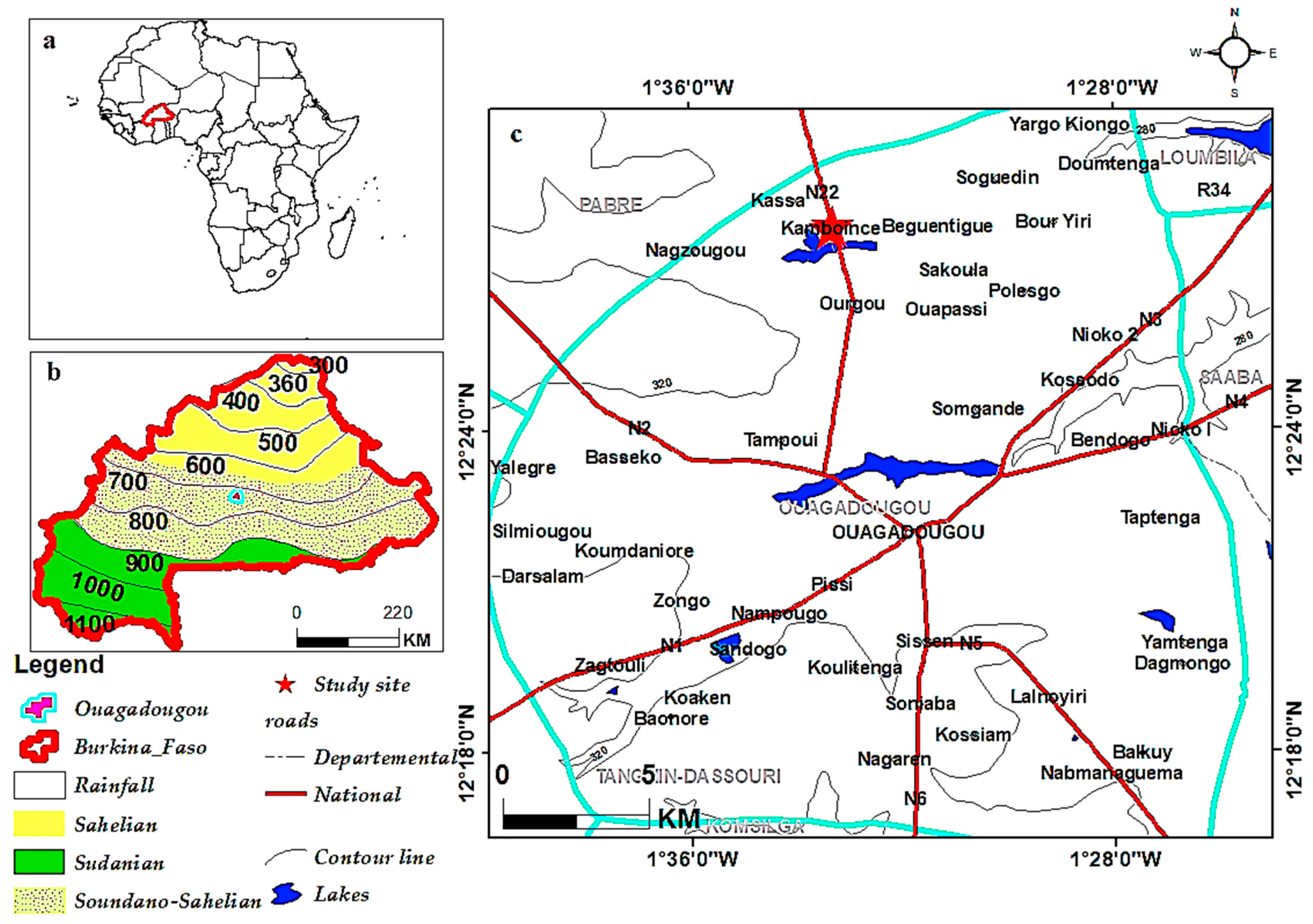
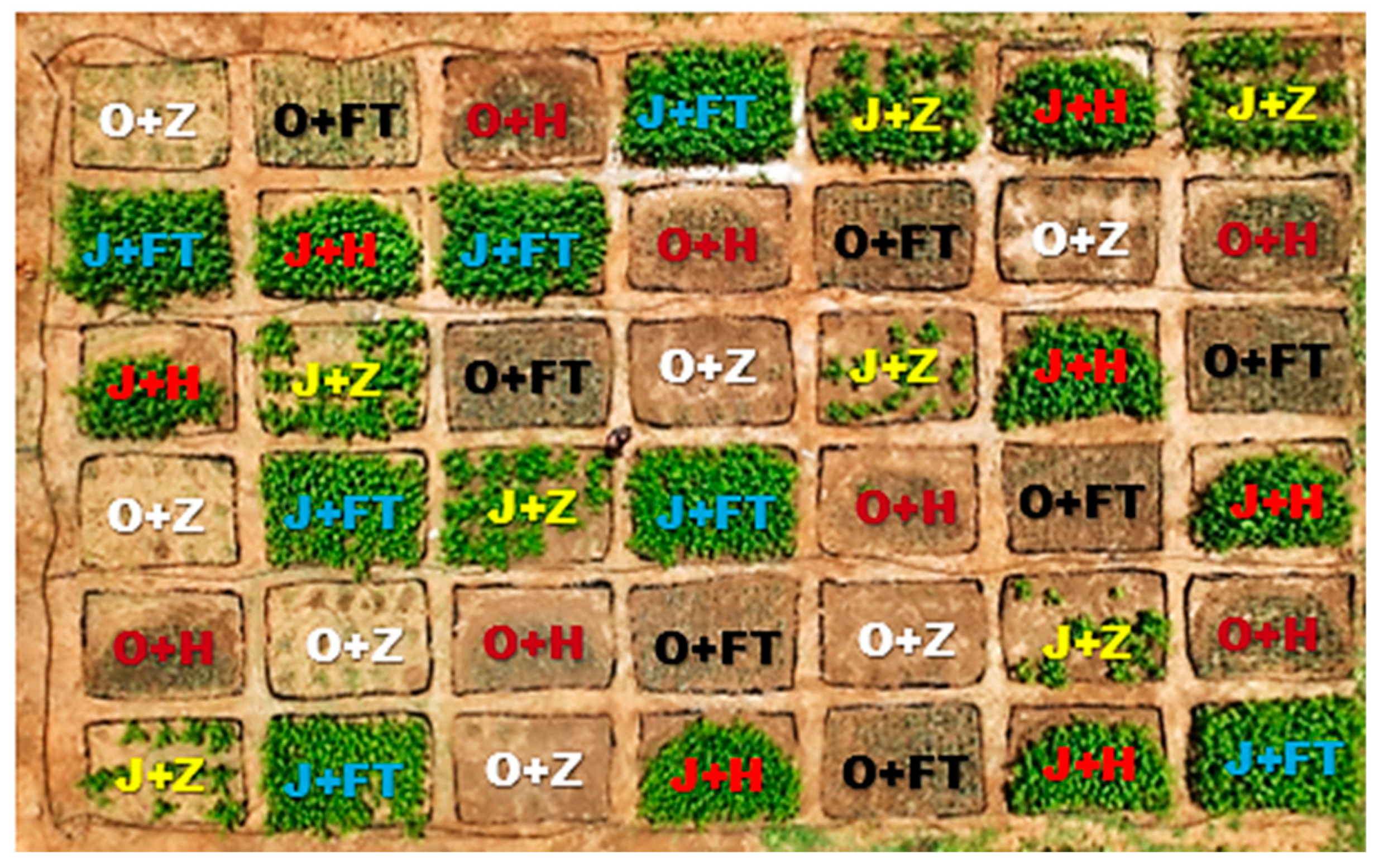


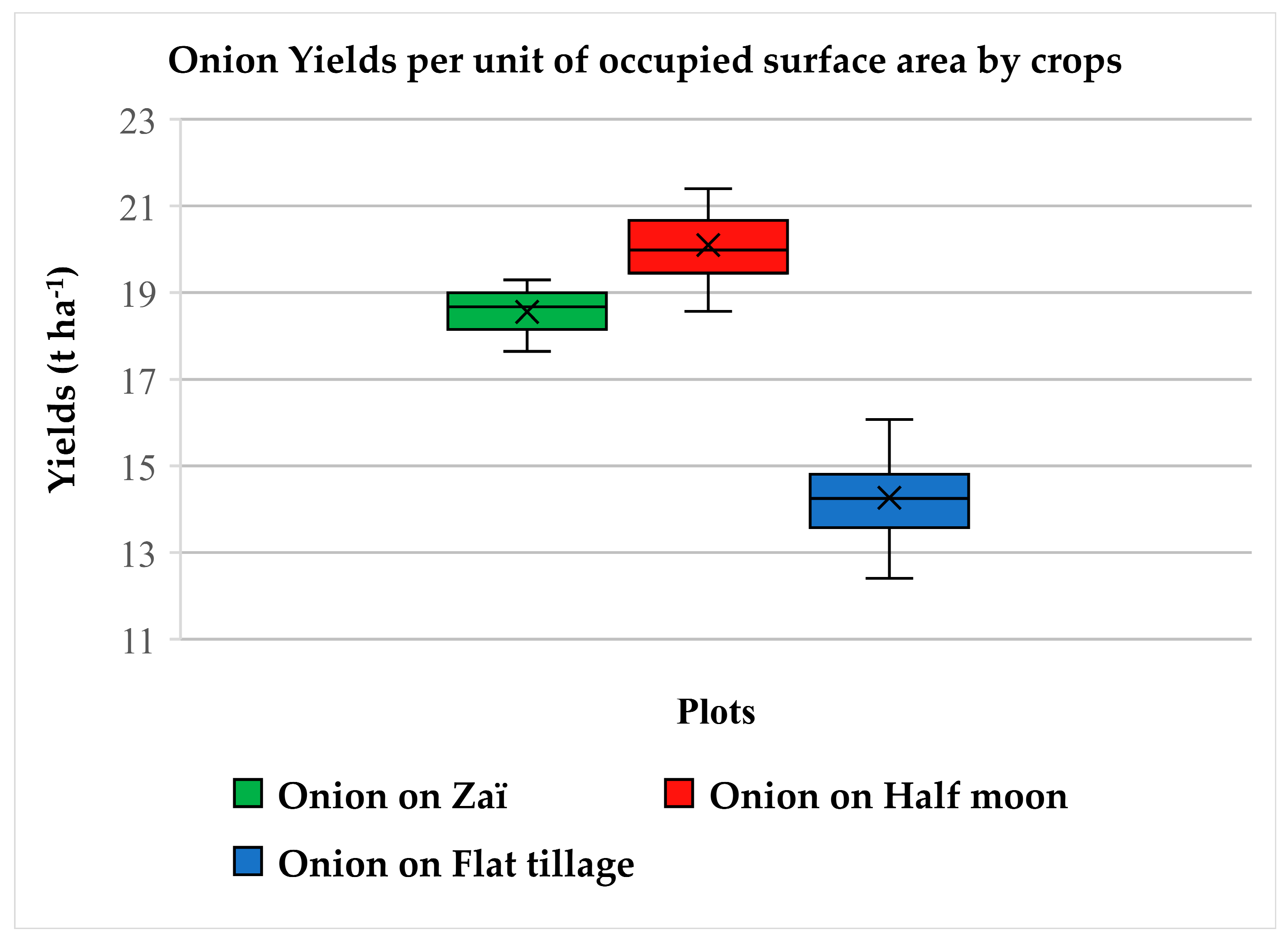
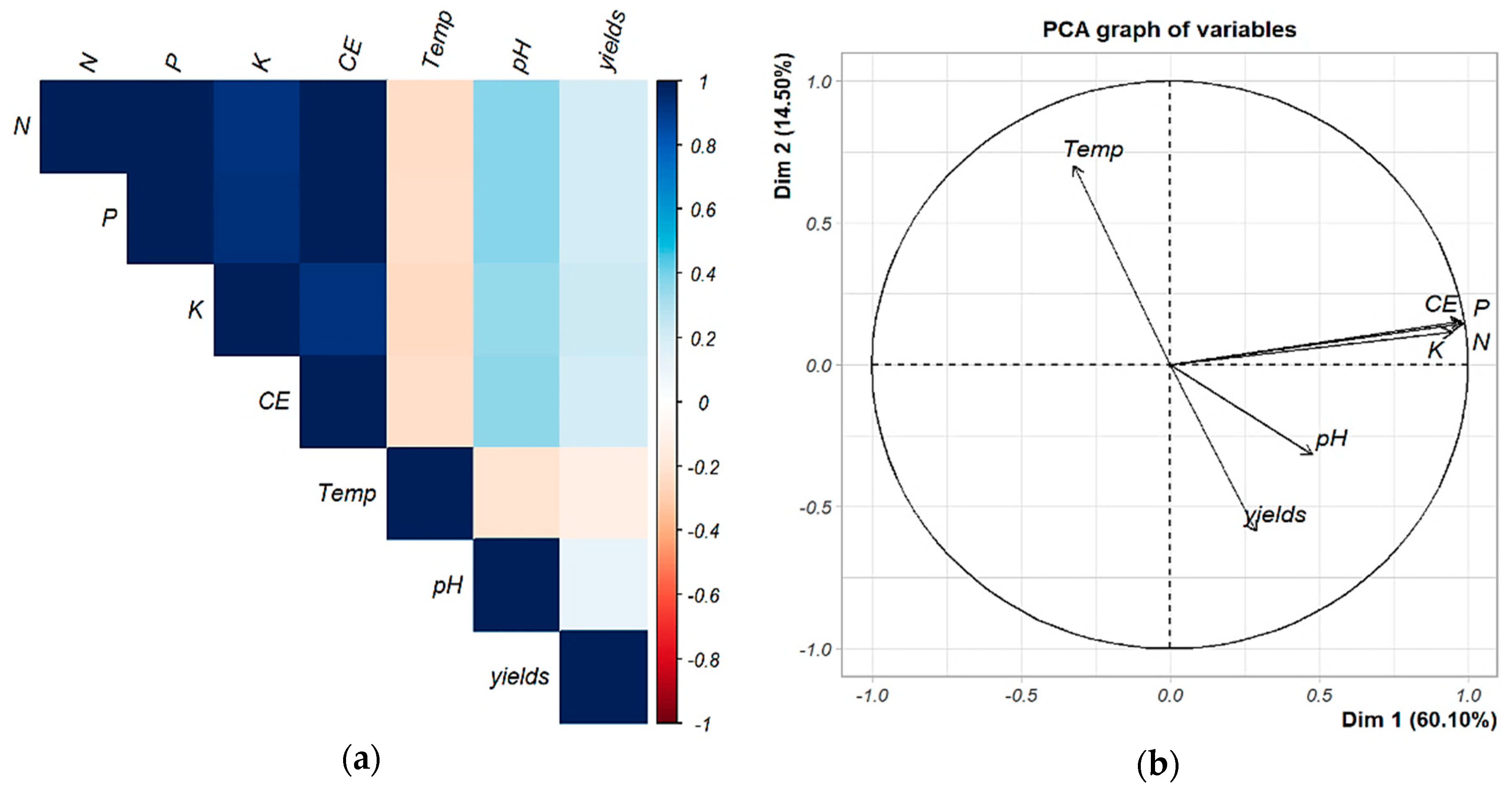


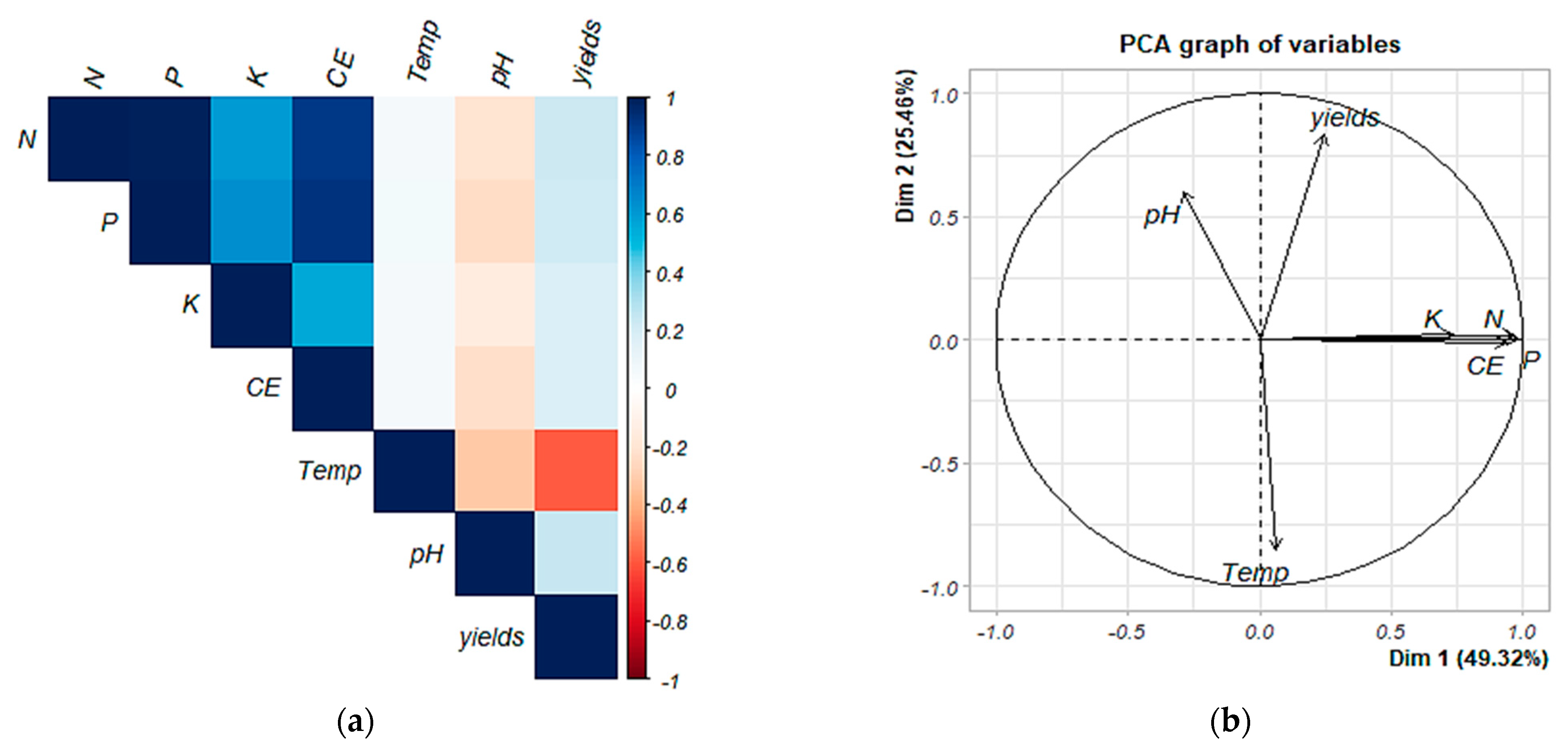

| Variables | Normality Tests | Levene Tests | ANOVA Test | Tukey (HSD) Test | |||
|---|---|---|---|---|---|---|---|
| Plots | Tests Applied | (p-Values) | (p-Value) | Pr > F/F | Groups | ||
| Onions on Half-moon | Anderson–Darling | 0.60 | 0.18 | 0.01/527.86 | A | ||
| Onions on Zaï | 0.80 | B | |||||
| Onions on flat tillage | 0.39 | C | |||||
| Harvests | Categories | Normality Tests | Levene Tests | ANOVA Test | Tukey (HSD) Test | |||
|---|---|---|---|---|---|---|---|---|
| Plots | Tests Applied | (p-Values) | (p-Value) | Pr > F/F | Groups | |||
| First harvest | Jute on Half-moon | Anderson–Darling | 0.29 | 0.09 | <0.01/35.18 | A | ||
| Jute on Zaï | 0.19 | B | ||||||
| Jute on flat tillage | 0.75 | B | ||||||
| Second harvest | Jute on Half-moon | Anderson–Darling | 0.34 | 0.32 | <0.01/183.98 | A | ||
| Jute on Zaï | 0.46 | B | ||||||
| Jute on flat tillage | 0.72 | C | ||||||
| Third harvest | Jute on Half-moon | Anderson–Darling | 0.09 | 0.33 | <0.01/74.51 | A | ||
| Jute on Zaï | 0.54 | A | ||||||
| Jute on flat tillage | 0.35 | B | ||||||
Disclaimer/Publisher’s Note: The statements, opinions and data contained in all publications are solely those of the individual author(s) and contributor(s) and not of MDPI and/or the editor(s). MDPI and/or the editor(s) disclaim responsibility for any injury to people or property resulting from any ideas, methods, instructions or products referred to in the content. |
© 2025 by the authors. Licensee MDPI, Basel, Switzerland. This article is an open access article distributed under the terms and conditions of the Creative Commons Attribution (CC BY) license (https://creativecommons.org/licenses/by/4.0/).
Share and Cite
Ayoumbissi Keugmeni, G.A.; Keita, A.; Yonaba, R.; Sawadogo, B.; Kengni, L. Towards Sustainable Food Security in the Sahel: Integrating Traditional Conservation Practices and Controlled Irrigation to Overcome Water Scarcity During the Dry Season for Onion and Jute Production. Sustainability 2025, 17, 2345. https://doi.org/10.3390/su17062345
Ayoumbissi Keugmeni GA, Keita A, Yonaba R, Sawadogo B, Kengni L. Towards Sustainable Food Security in the Sahel: Integrating Traditional Conservation Practices and Controlled Irrigation to Overcome Water Scarcity During the Dry Season for Onion and Jute Production. Sustainability. 2025; 17(6):2345. https://doi.org/10.3390/su17062345
Chicago/Turabian StyleAyoumbissi Keugmeni, Guy Armel, Amadou Keita, Roland Yonaba, Boukary Sawadogo, and Lucas Kengni. 2025. "Towards Sustainable Food Security in the Sahel: Integrating Traditional Conservation Practices and Controlled Irrigation to Overcome Water Scarcity During the Dry Season for Onion and Jute Production" Sustainability 17, no. 6: 2345. https://doi.org/10.3390/su17062345
APA StyleAyoumbissi Keugmeni, G. A., Keita, A., Yonaba, R., Sawadogo, B., & Kengni, L. (2025). Towards Sustainable Food Security in the Sahel: Integrating Traditional Conservation Practices and Controlled Irrigation to Overcome Water Scarcity During the Dry Season for Onion and Jute Production. Sustainability, 17(6), 2345. https://doi.org/10.3390/su17062345








